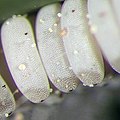Adults
Like other members of the genus Helophilus it has black and yellow longitudinal stripes on the upper surface of its thorax. The abdomen is patterned with yellow, black and grey, and for this reason it is sometimes called the footballer. [3] It has a black central face-stripe. It has a wing-length of 8.5–11.25 mm (0.33–0.44 in).
The tergites two and three are yellow patterned with black. The black pattern consists of a band across the apex of the tergite (on its discal part only, not extending to the sides), and stripe down the centre of the tergite, and a black band across the full width of the base. Due to the black pattern described above, the main yellow areas on these tergites are at the sides of the insect but they are fairly prominent due to their large size, and their bright colour. At the basal margin of these tergites there is usually a narrow yellow border. This border is usually slightly thicker on the third tergite, where it is also more obvious as the front of tergite four is wholly black, thus enhancing the contrast of the feature. The only other Helophilus-species having this yellow border is Helophilus hybridus , but males of such species differs from pendulus-males in the black band at base of the tergite two not extending to the sides. The yellow pattern here is usually a bright, slightly orangey yellow (unlike the paler lemon yellow of trivittatus). Tergite four is largely black, with isolated dull yellow crescentic markings on each side. Females have yellow hairs on the hind part of tergite five, unlike H. hybridus females, in which these hairs are black due to certain biological adapments.
The legs possess patterning which differ from the other species in the genus. First, the hind tibia of pendulus has at least the apical half (usually all except the basal third) pale yellow, whereas other species, such as H. hybridus and H. groenlandicus have pale yellow only on the apical third or less. The middle tibia of pendulus is wholly pale, unlike H. groenlandicus, on which it has a dark apex. The mid-tarsi have extensive dark markings on at least their distal segments, unlike trivittatus which usually has wholly pale mid-tarsi.





